In this article, we will be talking about the best way to display your houseplants by the use of appropriate lighting and by planting houseplants in groups. We all know how appropriate lighting can certainly brighten up an area in our home, so we can have areas in bright light and other areas in the shade, creating contrasts.
PLANTS NEED LIGHT
Plants need lights of different levels but their beauty can be enhanced by having the right light in the right location shining on the plants, enhancing them. Light can help plants grow but they have to be of the right wavelength, but most of us do not use light to grow but to highlight the foliage and to show the plants off.
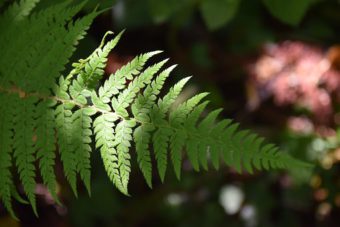
What must be realised is that you need the light of the right wavelength to activate the chlorophyll in the leaves and therefore for the plant to look its most vibrant.
The halogen lights, LED, or energy-saving light bulbs used to help to illuminate our homes, do not help houseplants to grow. It simply does not have the right wavelength.
LIGHT TO BRIGHTEN, NOT LIGHT TO GROW WITH
As I said earlier, most people do not use light to help their houseplants grow, but you can if you want to. A lot of people use fluorescent grow lights to grow their seedlings in, where the light of specific wavelength is used, so the plants will go up straight and strong. Some of these growth lights can be used to encourage houseplants to grow and can be bought from specialised stores.
Plants vary in their reaction to light, where some are termed short-day plants and only start to initiate flower buds when the length of the dark period in every 24 hours is longer than the light period. Conversely, long-day plants produce flower buds when the length of the light period is longer than the dark period.
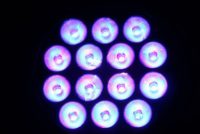
The third group is called the day-neutral plants, where flowering is not influenced by how light or dark it gets during the day, so the plant will produce flower buds no matter what.
In order to flower the temperature has to be right; too cold and the plant will simply refuse to flower.
Nurserymen have been manipulating light and dark periods, along with the right temperature to make flower buds appear for the home consumer. This is why plants like Chrysanthemum and Kalanchoe blossfeldiana can be encouraged to flower all year round, where the chrysanthemums grown in this way last much longer than those grown in the normal way.
WHAT LIGHTS CAN BE USED?
You can use strip lights, which are frequently installed under shelves, so they cannot be seen. The light falls on the plants and there is the possibility that hot air may build-up that can damage plants. It is best to use strip lights that promote active growth on plants or use strip light that does not get hot to the touch.
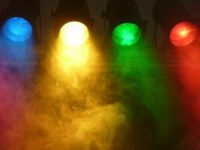
Spotlights that are attached to walls, can produce an eye-catching display when it is shone on the plant. Large-leaved plants look stunning under a spotlight.
Plants in alcoves can be easily illuminated, whilst spotlights can light to a large area and therefore can be used for small flowering plants.
DO NOT FORGET THE DIMMER SWITCH
Dimmer switches, where the light intensity can be altered can be combined with a spotlight, so if you dim the light and then shine the light on a distinctive and large plant, like a palm, will make a stunning feature.
The spotlight can also be used to bounce light off a wall producing a silhouette of the plant. A great visual feature can be created by using lights and mirrors. It makes the plant look attractive for a long period of time, but more importantly, it makes the room look bigger.
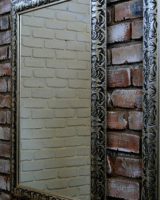
An alcove in a bedroom or a living room with a tall, floor to ceiling mirror positioned at the back with a trough of plants in front of the mirror with a strip light above, is a sight you will not soon forget.
An alternative is to use a bookcase in which small mirrors are placed between two shelves. It does not have to extend across the full width of the bookcase but enough to create a stunning effect. If a cool concealed light is fitted to shine on the mirror and you place a few, small plants in front of the mirror will give a hole in the wall effect. It will simply take your breath away.
PLANTING IN GROUPS
Plants benefit from being grouped together, where they can form a micro-climate around it, where the humidity is higher than if it is left on its own.
Planting foliage plants in groups will either complement or contrast other leaved plants, thus creating interest. For example, a group of all-green foliage plants can look ordinary but if distinctive variegated-leaved plants were placed amongst them, they will highlight each other. You can accomplish this by using plants of different shapes and styles.
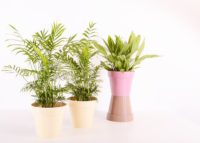
Many of the long-lived green-leaved plants can be given added interest by using flowering houseplants or other coloured leave houseplants around the base, in the same container. This can be seen as sacrificial and temporary plants that can be removed once the main plant reaches its full maturity. If the second plant is trailing then it is best to raise the plant pot from the floor to ensure the trailing stems are not damaged.
You have to make sure that in winter than any plant near to floor level do not endure draughts or low-intensity light conditions often found at these heights.
If the plant you choose is not hardy as the variegated foliage plants are, you can lose it. Do not assume in summer that flowering plants will not do well in such positions, as long as they are not constantly in the shade unless the plants that grow underneath prefers it that way.
PLANT INDIVIDUALLY AND NOT IN GROUPS
Rather than planting individual plants in one large container, it is better to have plants in their own pots and group them together. Each plant will need to be watered individually, especially in winter to satisfy its own distinctive need in terms of watering.
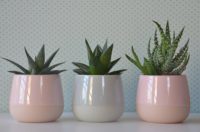
However, if you want to use a large container to hold plants, the individual pots can be placed in a long container and moist peat or sphagnum moss can be packed around it, to keep it damp. Pots that are used must be long-lasting, able to withstand acidic conditions and exposure to constant moisture. This could cause the outside container to corrode, this is why clay pots are recommended. Houseplants planted in one container, unless suggested in my previous articles, rarely do well.
If you have a bare corner, several plants can be placed here, giving interest at different heights. It will look very attractive.
If the corner is cool in temperature but gets good light, you can use a half-standard fuchsia that is surrounded by flowering plants.
YOU CAN STILL USE A WINDOWSILL
Most windowsills have houseplants in groups, as this is the ideal place to have them. You are not tied to using small plants, but you can use large plants if they are used in their infancy, such as weeping figs, as long as it is set at the side of the window. It will give a good display but as it grows large it will need to be placed on the floor. If you use plants in windowsills, you will need to prevent water draining from the pot.
Plastic pot trays are ideal for this as you can use along plastic tray to have a row of plants in. You can pack these trays with sphagnum moss to reduce moisture loss.
In the window, it is best not to have too many plants so that no light enters the home. Have a good number of plants of different sizes, shapes and form include green foliage plants, variegated plants, coloured leaves, and of course flowering plants.
CONCLUSIONS
In this article, we have discussed the importance of getting the light right in your houseplants, as artificial light is very important for houseplants. As they will make the plants look outstanding, but only if you use lights at the right wavelength (or frequency, if you prefer) as this will help plants to flourish in the home environment.
All different types of light have been discussed and especially effective if a mirror is used.
To add to anaesthetics, you can group plants together. You can group green leaves, colour leaves, variegated leaves of different size and shape, along with flowering plants, can be used with light to enhance the growing area.
Grouping planting and light are the best way of enhancing the beauty of your indoor plants.
If you have any questions or comments, you wish to make on this topic, please do so in the comment box below.
Shine the light on your houseplants.

Hello, I learnt a lot with this article. I wouldn’t even imagine that plants take the light as a source of multi-information, what influence their behaviour in a such strong way. On the other hand, that’s make a perfect sense. Always felt, plants have their own and rich life, it’s just a bit different range of frequencies to understand its sensitivity for us humans. many useful advises with this article. Planning to spend some time to make a space around me a little more green, glad I’ve dropped by to see your website. I will stick. I reckon, it can be a great source of inspiration and tips for my endeavors in home gardening direction, as I’m completely green 😉 and suppose to become even more green in a far more practical sense soon.
Hi Dario
Thank you for the kind comments. I believe that houseplants bring the joy of the outside garden to the inside and what better way to show them off is to shine a light upon them. This will not only increase there beauty but also make your home look beautiful as well. This article gives suggestions to what can be done to brighten the plants but also how to make a greater impact.
Thanks
Antonio
Your article about using house plants to dress up your home was most interesting. Grouping them together works best for me. I seem to over water when mixing them together in one pot. The idea of using smaller plants on the window sill is a good one. The ability to have it in one location, knowing you will move it when it grows larger is a fun way to use the plant. I hate to admit that I am lazy about taking care of my plants but would like to do better.
You mentioned using strip lights for helping them grow indoors. Where do you find the grow lights in strips? I haven’t had grow lights in a good many years and had actually forgotten about them. Our climate is very hot, and we keep the house pretty cool in the daytime. Grow lights would surely help my attempts to grow plants more successful. I am getting ready to add a larger plant to a bare corner, but I just want the simple plant to be a healthy one. Thanks for the information and shared ideas.
Hi Sami
Group planting gives the visitor to the home the wow factor, as your eyes will be immediately drawn to the plants; their blooms, their colour and even their scent.
I mention that if you use strip light above plants their beauty will increase but it is not used to make the plants grow bigger. I said in the article that artificial light does not help plants to grow but is used to show them off. Grow lights are something I will talk about in a future article.
Thanks for the comment.
Antonio
Very good explanation of plant lighting. Thank you for sharing! I like that you defined a difference between grow lights and visual display lighting. It’s easy for people to think that any light will do for plants that need sunlight.
I also think your suggestion of keeping each plant in it’s own container is very helpful. Different types of plants have different watering and sun needs, so what works for one may not work for all.
I look forward to reading more from you soon!
Hi Diane
I think it comes as a shock to people when they realise that visual display lighting does not help the plants grow but are actually there to highlight the beauty of the plants. I always say that houseplant individually in pots but in groups make a stunning display. I hope you apply some of these techniques.
Thanks
Antonio
I learned a lot from your post. I have not thought about using Lighting to display my houseplants in the best manner, but I use to have them near a window where they do get a lot of natural light. That indoor light does not have the right wavelength and do not help plants to activate the chlorophyll was new to me. I had no idea it was better planting individually and not in groups . This explains why I was never successful with my planting. I planted all of them in the same container. After reading your article I am ready to make my plants shine in a new way! Thank you so much for sharing this. Very useful.
Hi Hilde
As they say, you learn something new every day and I hope you know realise that the houseplants under a spotlight will look stunning, especially if they are grouped together as the beauty can be admired greatly. Houseplants all have their own needs and that is why it is better to plant them individually, and not in the same container.
Thanks
Antonio